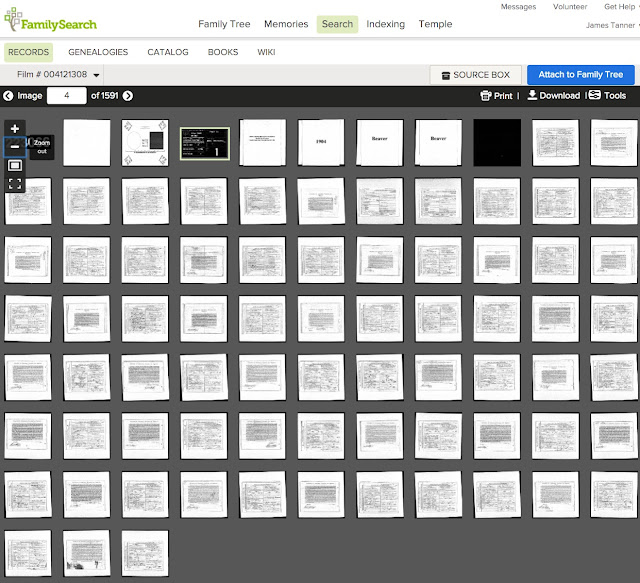Unless you are involved in doing serious genealogical and family history research, these new features will probably be either unnoticed or ignored. Even my explanation will be meaningless to those people who do not do in depth research involving microfilm. These new features start out by highlighting the importance of the FamilySearch Catalog. I taught a class this week at the Brigham Young University Family History Library that will shortly be uploaded to the BYU Family History Library YouTube.com Channel. This class outlines some of my current research strategies. The conclusion that I come to regarding online searches is that it is still necessary, in many cases, to go to the FamilySearch.org microfilm collections after you exhaust online resources. I presently have a series of over fifty microfilms that I will need to search. The new features implemented by FamilySearch.org will immeasurably improve this process.
Let's assume that I want to research English parish records. In my case, I would like to find my ancestors in Huntingdonshire. My current records show that my ancestor, Thomas Parkinson, (b. 1830, d. 1906) was born in Farcet, Huntingdonshire, England. This information comes from records in the United States after he immigrated in 1854.
After extensive online searches, I have yet to locate a birth record. I do find an 1841 England, Wales and Scotland Census record showing his family, including his parents, James and Elizabeth Parkinson. He is shown as 10 years old in 1841. The family is living on Glassmoor Street in the parish of Whittlesey St. Mary & St. Andrew in Cambridgeshire. One of my options, of course, is to examine the parish register for his reported birthplace. As far as I can determine, the most available copy of the Farcet parish registers are in the FamilySearch.org microfilm collections.
Here is a screenshot of the FamilySearch.org Catalog entry for Farcet's Church Records. Note that "Farcet" is spelled as "Farcett." Apparently both spellings are used.
I can check to see if perhaps some or all of these microfilms are already available at the Brigham Young University Family History Library and if not, I can order them into the Library. (Note: there is no charge for ordering microfilm into the BYU Family History Library from the Family History Library in Salt Lake City, Utah and once the films arrive in about two weeks, they stay the copies of the film are permanently kept by BYU).
I can then look at the individual entries for each of the four microfilm records listed. The first is the Bishop's transcripts for Farcett, 1660-1857. This covers the time period I am searching so this one goes on my list. But, here is the new feature from FamilySearch. The microfilm listing has two icons. Here is a screenshot.
These are the icons for the new features. The round icon indicates that the records are available on microfilm. The magnifying glass lets you search for similar records already digitized. I must note that this collection of Farcett records is NOT in the digitized records in the Historical Record Collections on FamilySearch.org. Here is a screenshot of the assisted search.
There are 292 entries on this particular search and there are 31 people named Thomas. However, none of these is my Thomas, but I do have a second search that helps to establish that I do need to order the microfilm. I can now order the two microfilms that pertain to the time period I am searching.
Now, what happens if the record has been digitized? Unfortunately, none of the records I am interested in at the moment seems to have been digitized. So, I have to go to some other records for an example of what happens if they are digitized.
This is a screenshot of the microfilm list for Utah death certificates, 1904-1951.
The little camera icon allows you to see the entire roll of microfilm in thumbnails.
You have to have worked through hundreds of microfilm rolls to fully appreciate what this view does for research. You can instantly see the headers and breaks in the different microfilm records on the roll and you can jump to any record and search the roll completely on any computer. This is a great, great benefit.
There are some more important features announced in the post I linked to above. I will be highlighting how those affect research in subsequent posts.









So cool!
ReplyDeleteJames, I see an ability to Attach to Family Tree in the top right corner. What attaches - the digital doc? And Where does it attach - in Memories as a doc, or in the Create a Source Template with a URL?
ReplyDeleteGood question, the Family Tree is not working for sources right now. When it is working, I will take a look.
Delete